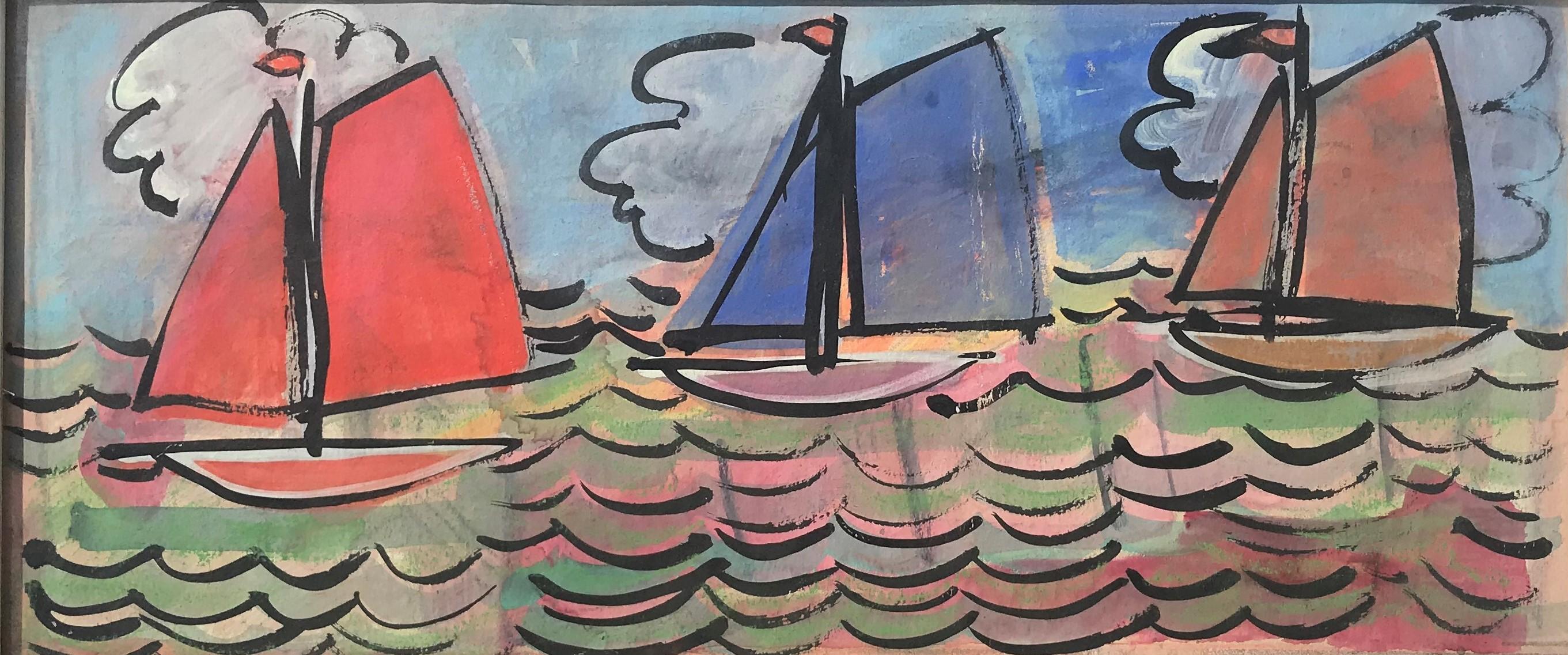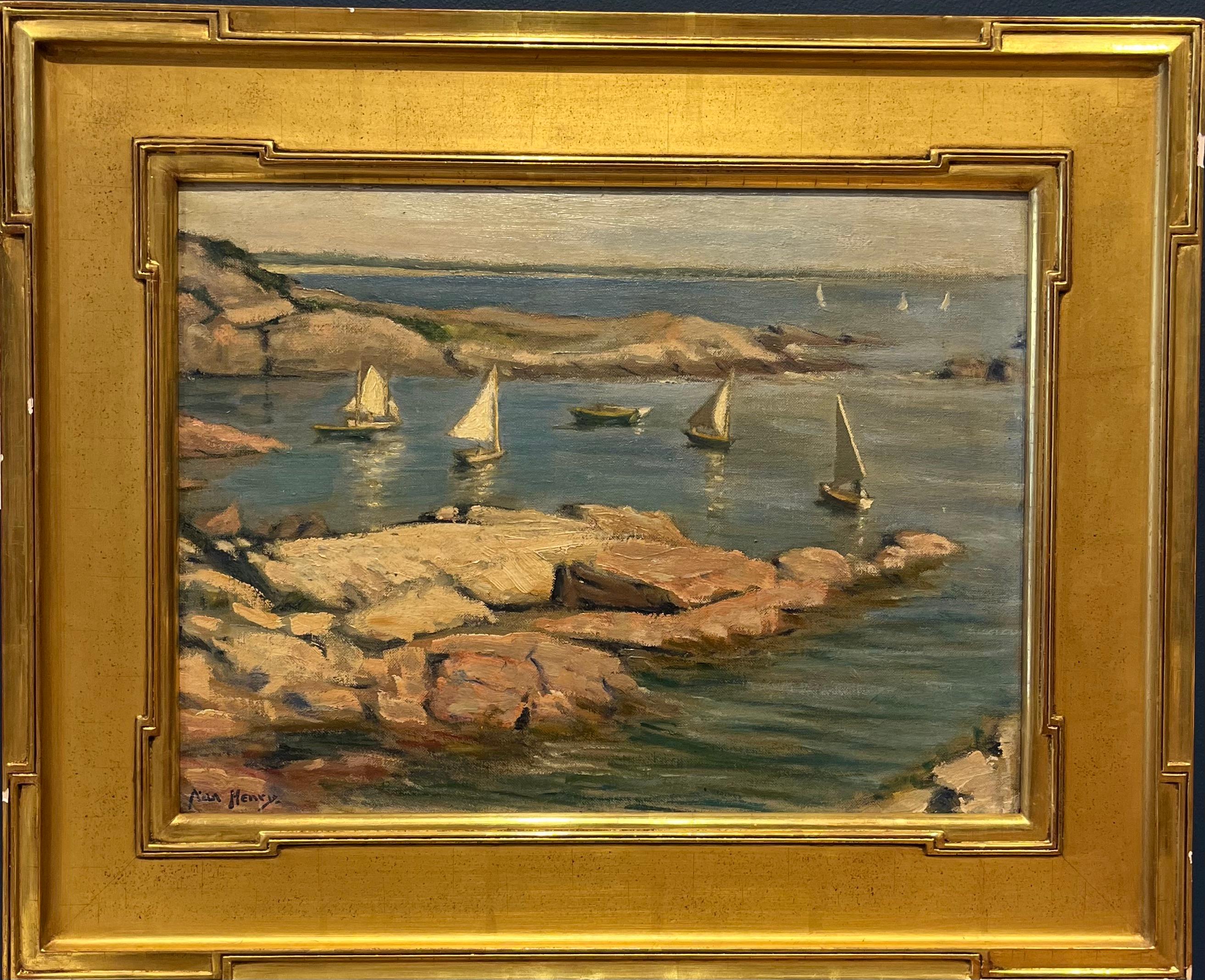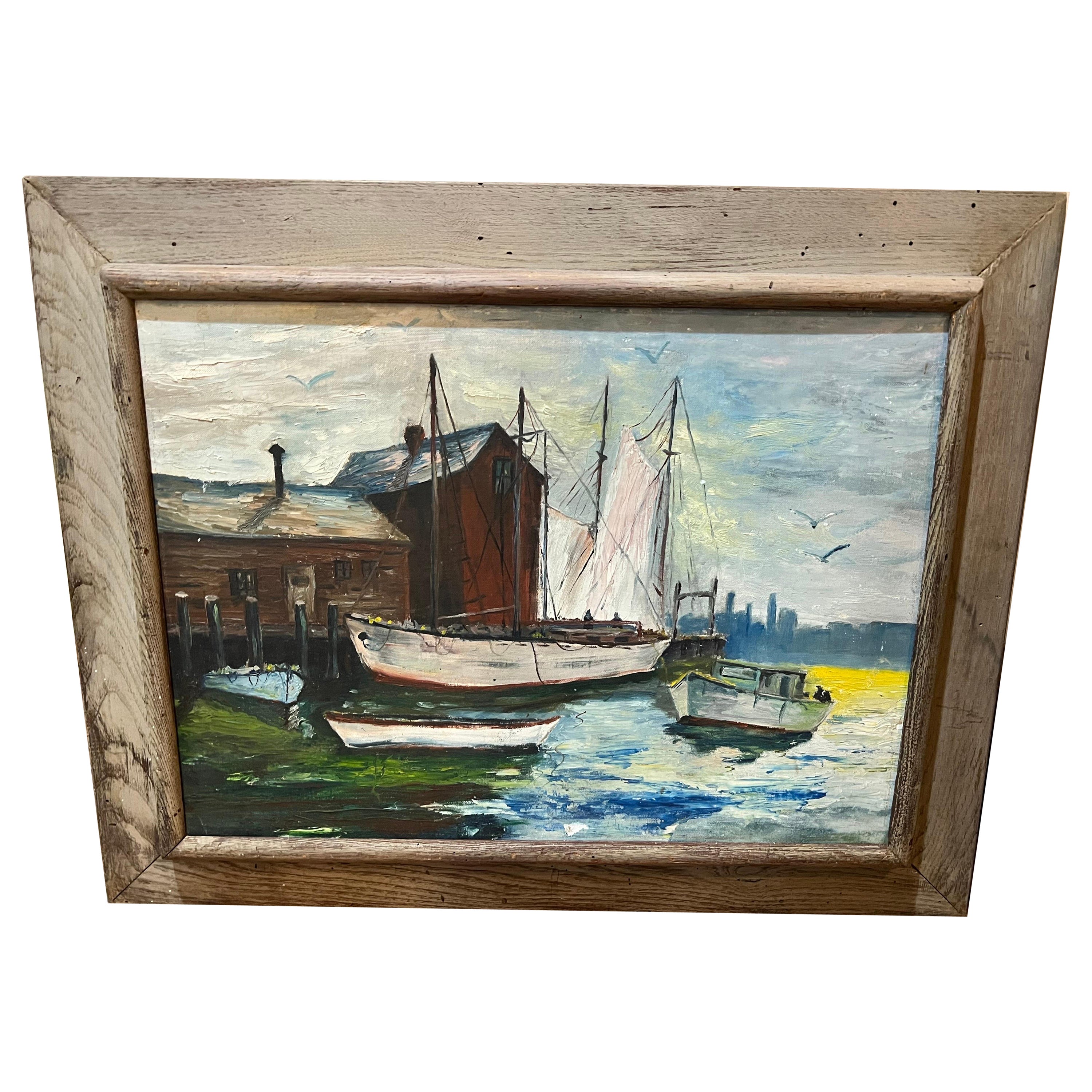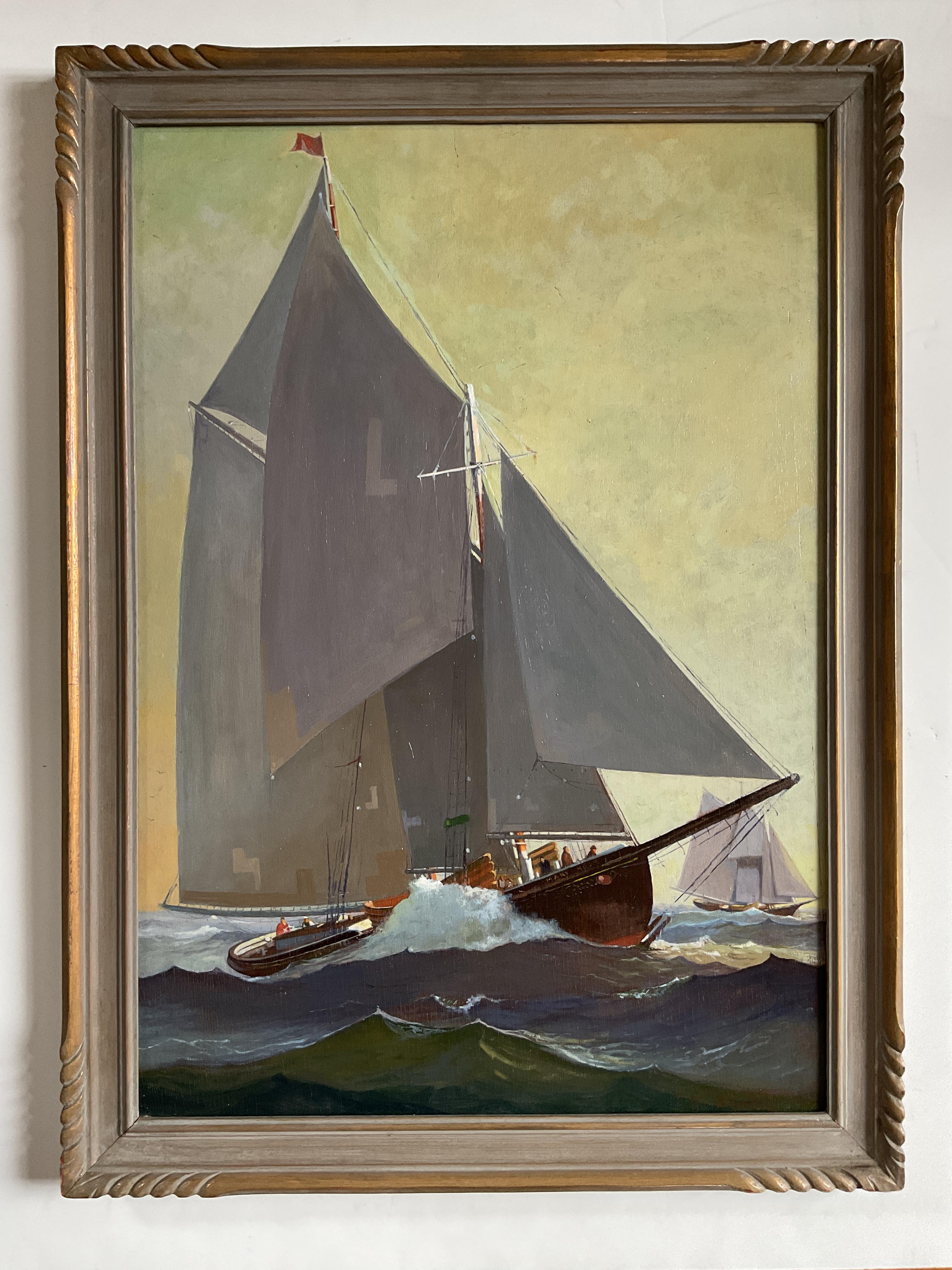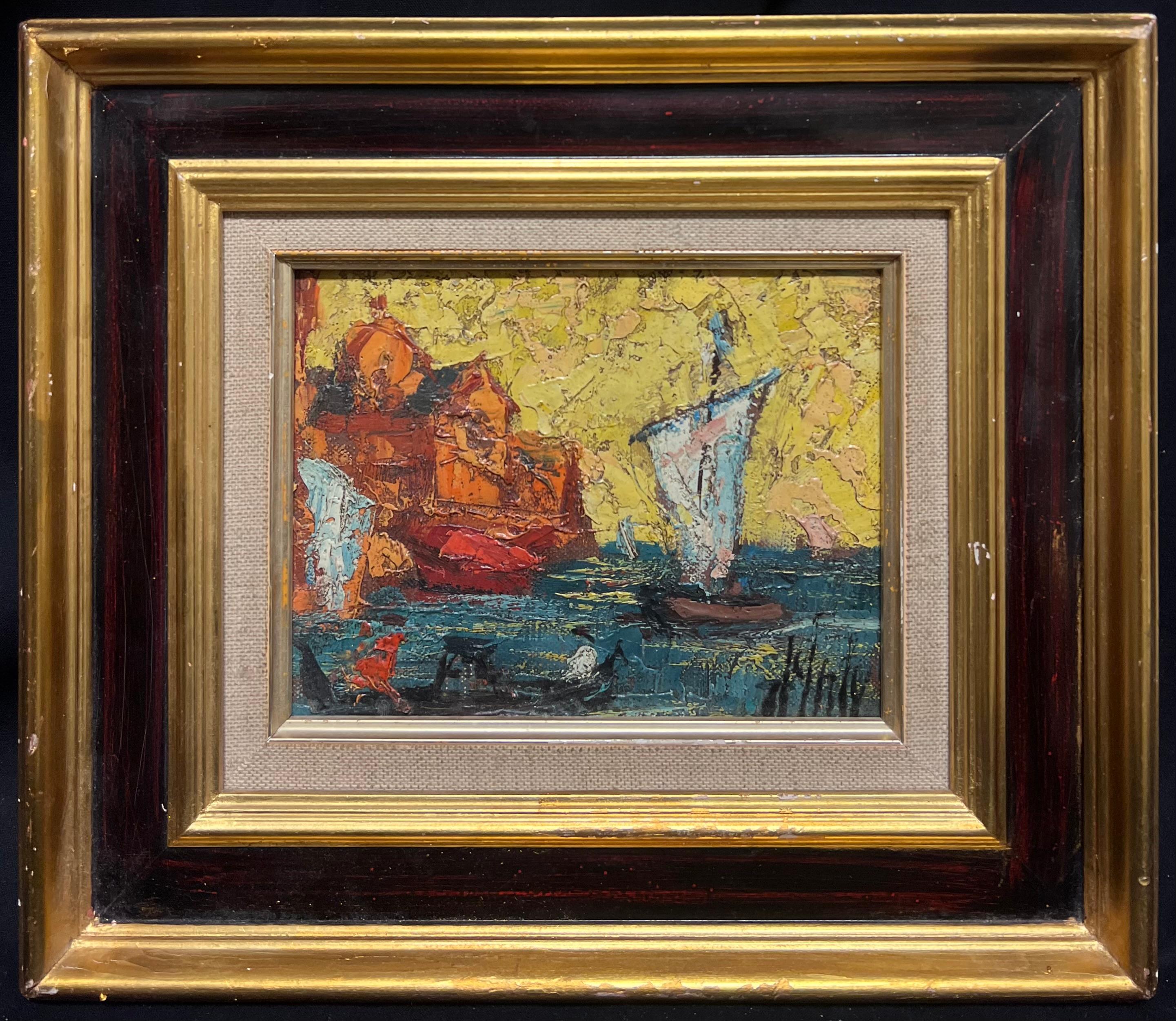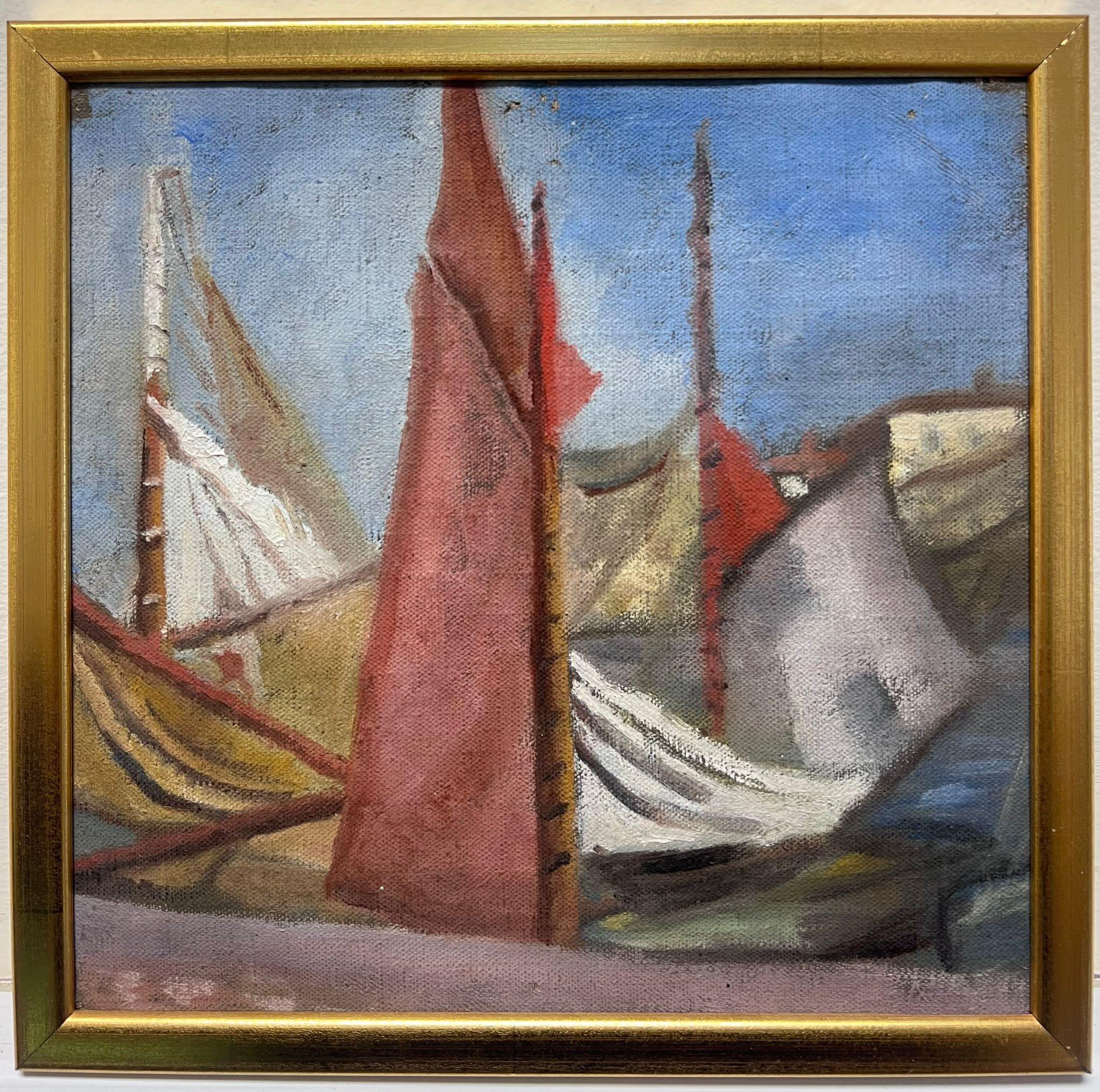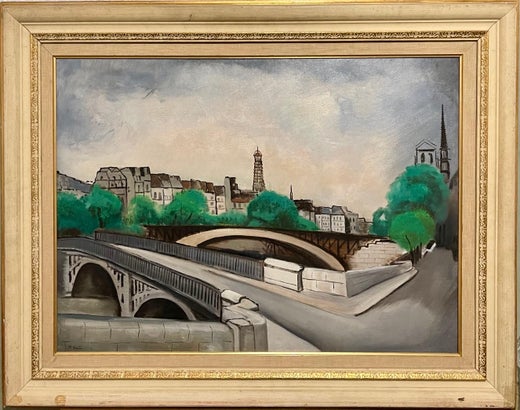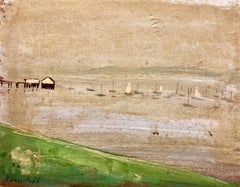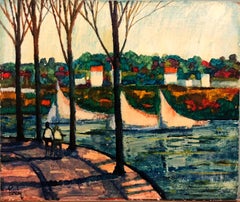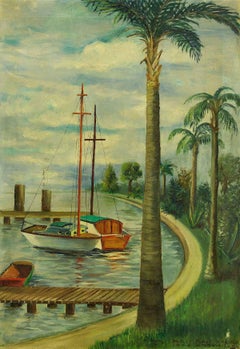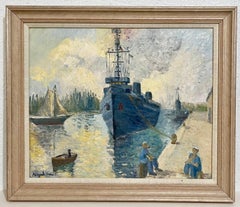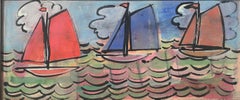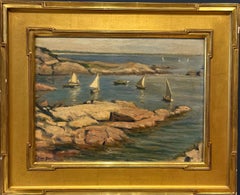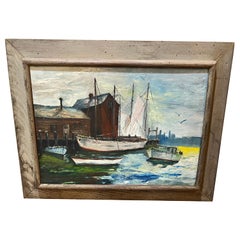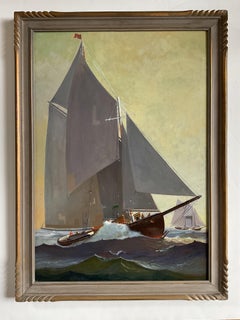Items Similar to 1930 Oil Painting Sea Side Sailboats American Modernist WPA Artist Morris Kantor
Want more images or videos?
Request additional images or videos from the seller
1 of 16
Morris Kantor1930 Oil Painting Sea Side Sailboats American Modernist WPA Artist Morris Kantor1930
1930
$6,500
£4,927.89
€5,680.56
CA$9,154.21
A$10,151.34
CHF 5,333.78
MX$124,032.10
NOK 66,732.81
SEK 62,640.14
DKK 42,406.47
About the Item
Morris Kantor, American, 1896-1974
Seaside View, 1930
Hand signed M. Kantor and dated 1930 lower right
Oil on canvas
22 1/4 x 19 1/4 inches
24 1/2 x 21 (frame)
Morris Kantor (Belarusian: Морыс Кантор) (1896-1974) was a Russian Empire-born American painter based in the New York City area. This is a beautiful boat scene with a river or lake probably on Long Island.
Born in Minsk on April 15, 1896, Kantor was brought to the United States in 1906 at age 10, in order to join his father who had previously relocated to the states. He made his home in West Nyack, New York for much of his life, and died there in 1974. He produced a prolific and diverse body of work, much of it in the form of paintings, which is distinguished by its stylistic variety over his long career. Perhaps his most widely recognized work is the iconic painting "Baseball At Night", which depicts an early night baseball game played under artificial electric light. Although he is best known for his paintings executed in a realistic manner, over the course of his life he also spent time working in styles such as Cubism and Futurism, (influenced by the Art Deco movement) and produced a number of abstract or non-figural works. A famous cubist, Futurist, painting of his "Orchestra" brought over 500,000$ at Christie's auction house in 2018. Kantor found employment in the Garment District upon his arrival in New York City, and was not able to begin formal art studies until 1916, when he began courses at the now-defunct Independent School of Art. He studied landscape painting with Homer Boss (1882-1956). In 1928, after returning to New York City from a year in Paris, Kantor developed a style in which he combined Realism with Fantasy, often taking the streets of New York as his subject matter. He did some moody Surrealist Nude paintings and fantasy scenes. In the 1940's he turned towards figural studies. Later in his career, Kantor himself was an instructor at the Cooper Union and also at the Art Students League of New York in the 1940s, and taught many pupils who later became famous artists in their own right, such as Knox Martin, Robert Rauschenberg, Sigmund Abeles and Susan Weil. He married fellow artist Martha Ryther (1896–1981). He taught at the League from 1936 to 1972, until his illness prevented him from continuing to teach. In addition to his downtown Manhattan studio adjacent to Union Square, he also maintained a studio on Cape Cod in Wellfleet, Massachusetts. Like many American artists, in the 1920s he also spent time working in Paris, where his circle included sculptor Isamu Noguchi among others. The 1930s found him in the position of supervisor of the Federal Art Project Easel Painting Project in Rockland County, New York. In the 1940s some of his summers were spent in Monhegan, Maine. In the 1960s, Kantor exhibited his work at the Bertha Schaefer Gallery, New York, NY. He was active in sketching and drawing through the early 1970s, until shortly before his death. He died at the age of 77, after battling a two-year illness. Kantor's work is on display in many prominent museums, including the Smithsonian American Art Museum and the Hirshhorn Museum.
Awards and honors
Logan Medal of the Art Institute of Chicago, 1931
Temple Medal of the University of Illinois, 1951
Active in both the Public Works of Art Program (PWAP): A federal New Deal program designed to support artists.
and the Works Progress Administration or Work Projects Administration (WPA): He was counted amongst the American Scene and Regionalist painters who focused on scenes of rural life. These painters used a naturalistic style that romanticized life away from industrial settings. Some other well-known artists of this movement are Thomas Hart Benton, Grant Wood, and John Steuart Curry. He was also a proponent of Social Realism, focused on issues of social, racial, and economic injustice and hardship. Artists Jacob Lawrence, Romare Bearden, Reginald Marsh, and Dorothea Lange were all part of the Social Realism movement. During its eight years of operation, the WPA would include within its ranks such iconic artists as Adolph Gottlieb, William Gropper, Philip Guston, Morris Kantor, Lee Krasner, Louise Nevelson, Diego Rivera, Mark Rothko, Ben Shahn, the Soyers (Isaac, Moses, and Raphael), and many other Jewish artists. Today Kantor's work can be found in such institutions as: the Whitney Museum of American Art, NY; the Metropolitan Museum of Art, NY; the Museum of Modern Art, NY; the Art Institute of Chicago; and the Pennsylvania Academy of the Fine Arts. Source: Peter Falk, Who Was Who in American Art
His work is in a current show, Alone Together: Encounters in American Realism at the Westmoreland Museum of American Art. The exhibition includes major magic realist and American scene paintings from the collection of Jason Schoen, one of the most important holdings of such work in private hands. Including George Tooker. Grant Wood, Morris Kantor, Pavel Tchelitchew and Thomas Hart Benton.
- Creator:Morris Kantor (1896 - 1974, Russian)
- Creation Year:1930
- Dimensions:Height: 24.5 in (62.23 cm)Width: 21 in (53.34 cm)
- Medium:
- Movement & Style:
- Period:
- Condition:minor wear. frame has wear. please see photos.
- Gallery Location:Surfside, FL
- Reference Number:1stDibs: LU38211616202
Morris Kantor
Morris Kantor was born in Minsk, Russia in 1896, and moved to New York in 1906. Early in his career he experimented with Futurism and Cubism. In 1916 he studied landscape painting with Homer Boss (1882-1956). In 1928, after returning to New York City from a year in Paris, Kantor developed a style in which he combined Realism with Fantasy, often taking the streets of New York as his subject matter. By 1940, he was focusing on figural studies. Today Kantor's work can be found in such institutions as: Whitney Museum of American Art, NY; Metropolitan Museum of Art, NY; Museum of Modern Art, NY; Art Institute of Chicago; Pennsylvania Academy of the Fine Arts. Source: Peter Falk, Who Was Who in American Art
About the Seller
4.9
Platinum Seller
Premium sellers with a 4.7+ rating and 24-hour response times
Established in 1995
1stDibs seller since 2014
1,801 sales on 1stDibs
Typical response time: <1 hour
- ShippingRetrieving quote...Shipping from: Surfside, FL
- Return Policy
Authenticity Guarantee
In the unlikely event there’s an issue with an item’s authenticity, contact us within 1 year for a full refund. DetailsMoney-Back Guarantee
If your item is not as described, is damaged in transit, or does not arrive, contact us within 7 days for a full refund. Details24-Hour Cancellation
You have a 24-hour grace period in which to reconsider your purchase, with no questions asked.Vetted Professional Sellers
Our world-class sellers must adhere to strict standards for service and quality, maintaining the integrity of our listings.Price-Match Guarantee
If you find that a seller listed the same item for a lower price elsewhere, we’ll match it.Trusted Global Delivery
Our best-in-class carrier network provides specialized shipping options worldwide, including custom delivery.More From This Seller
View AllMarinescape with Boat Long Island NYC Oil Painting
By Boris Vassiloff
Located in Surfside, FL
Boris Vassiloff, Russian/American (1906 - 2000)
Artist Boris Vassiloff was born on March 24, 1906 to Julia Nikolaevna and Boris Ivanovich Vassiloff in Russia. He died peacefully on D...
Category
Mid-20th Century Impressionist Landscape Paintings
Materials
Oil, Board
River Walk, American Modernist Oil Painting Landscape with River and Boats
By Donald Roy Purdy
Located in Surfside, FL
Genre: Impressionist
Subject: marine landscape
Medium: Oil
Surface: Board
Country: United States
Dimensions: 20X24
Donald Roy Purdy is an American painter whose work evolved through...
Category
20th Century Impressionist Figurative Paintings
Materials
Oil, Board
Boats in the Harbor
By Shirley Plaut Schaefer
Located in Surfside, FL
Shirley Plaut Schaefer July 14, 1920 - October 6, 2017
Born and raised in Manhattan, she studied at the New York School of Fine and Applied Arts (Parsons) and the Art Students Leagu...
Category
Mid-20th Century Contemporary Landscape Paintings
Materials
Canvas, Oil
Oil Painting Harbor Scene with Naval Ships Sailors & Boats Hildegarde Hamilton
By Hildegarde Hamilton
Located in Surfside, FL
Hildegarde Hamilton (Florida, Virginia 1898-1970)
Oil on canvas painting of a docked navy ship with sailors on shore.
Hand signed lower left
Measures: Canvas 19"H x 23"W; Framed 23.5"H x 28"W.
Hildegarde Hume Hamilton (1898 - 1970) was active/lived in Florida, Virginia. He is known for Impressionist buildings in landscape and coastal view painting, illustration.
Hildegard Hume Hamilton was born in Syracuse, New York, in 1898. After her education there, and brief training at the age of six in art schools in Venice, Italy, while on a European sojourn with her father, she studied fine art at the Académie Julian, the École des Beaux-Arts and the Académie Grande Chaumière in Paris, France, during the 1920s and 1930s.
Back in the United States, Hamilton studied for a short time at the Herron Art Institute in Indianapolis, the Cincinnati Art Academy and under the tutelage of the landscape and maritime painter Anthony Thieme (1888-1954) in Rockport, Massachusetts. The Ainslie Galleries on Fifth Avenue held an exhibit of Hamilton’s French Alpine Scenes to much acclaim. Hamilton exhibited in venues throughout the city and sold as many as 300 landscapes. In 1927, Vice President Charles Gates Dawes acquired one of Hamilton’s paintings following her one person exhibit at the Women’s National Party Headquarters in Washington D.C. In the autumn of 1928, an exhibition of her landscapes and cityscapes at the Galerie Bernheim Jeune in Paris was widely and positively reviewed. In 1929, she became the first American woman to exhibit at Philip Dillon’s club –
L’Artistique, in Provence. She also contributed to the Salon des Artistes Independants in Paris. In 1930, Hamilton exhibited at the Carlton Hotel in Washington D.C. and in New York at the Grand Central Palace, American Art Association-Anderson Galleries on 57th Street, and the Huntington Bay and Yacht Clubs. During this period, the artist resided at 9 Gramercy Park in New York City. The picturesque neighborhood inspired Hamilton’s painting entitled 4 Gramercy Park, Mayor Harper’s House, Manhattan. C. 1930. The oil painting captures the red brick façade and intricate cast iron embellishments of 4 Gramercy Park, the former home of publisher and New York City Mayor James Harper (1795- 1869). The two lamps at the foot of the steps signify the home was a mayoral residence and remain at the site to this day. Mrs. Hamilton studied at the Art Students League, New York, New York, and the Cincinnati Art Academy, Cincinnati, Ohio. Hamilton exhibited her topographical street-scenes and landscapes widely throughout the United States with shows at the Syracuse, New York, Museum of Fine Art; the University of Kentucky; the University of Georgia, and most importantly, New York City’s Society of Independent Artists from 1929 to 1933, 1938, 1939, 1943 and 1944. She also illustrated books. Hamilton’s paintings are included in the collections of Wesleyan College, She was aof a generation of American artists that included Alfred Hutty, Wayne Beam Morrell, Frank Henry Shapleigh, Jane Peterson, Henry Martin Gasser, Emil Holzhauer...
Category
Mid-20th Century American Impressionist Landscape Paintings
Materials
Oil, Canvas
1927 Oil Painting Eiffel Tower Paris American Modernist Wpa Artist Morris Kantor
By Morris Kantor
Located in Surfside, FL
Morris Kantor New York (1896 - 1974)
Paris from the Ile St. Louis, 1927 (view of Eiffel Tower)
Oil painting on canvas
Hand Signed lower left.
Provenance: Hirshhorn Museum and Scul...
Category
1920s American Modern Landscape Paintings
Materials
Canvas, Oil
French Expressionist Ecole de Paris Oil Painting Boats on French Riviera
By Jean Vinay
Located in Surfside, FL
Jean Vinay was a self-taught artist though he received artistic guidance from Albert Marquet, the Fauvist, who he knew through his travels in French North Africa. Jean Viney...
Category
20th Century Expressionist Landscape Paintings
Materials
Canvas, Oil
You May Also Like
Sailboats at Sea, 20th Century French School, colourful original oil on canvas
Located in Naples, Florida
A distinctive mid-20th Century French School painting of three sailboats. Clearly influenced by the Dufy brothers the artist has created a lively scene...
Category
Mid-20th Century French School Landscape Paintings
Materials
Canvas, Oil
American Impressionist Oil Landscape Sailing Near Todd’s Point Greenwich, CT
Located in Fredericksburg, VA
This painting is signed lower left. Nan Watson is a female American artist from the early 19th century that is most commonly known for her floral paintings ...
Category
Early 20th Century American Impressionist Landscape Paintings
Materials
Canvas, Oil
Mid Century Painting of Sailboats in Harbor
Located in Redding, CT
Mid Century Painting of boats in Harbor. Framed in a mid century driftwood color frame. This item can ship parcel domestically for $49.
Category
Mid-20th Century Mid-Century Modern Paintings
Materials
Wood, Masonite, Paint
$450 Sale Price
35% Off
Vintage Yacht Race Oil Painting by Listed Artist Amos C. Brinton (1888-1982)
Located in Baltimore, MD
American painter and illustrator Amos Carter Brinton was born in Wilmington, Delaware in 1888. He went on to have a successful career in illustrations, mainly maritime themed. Fishi...
Category
1960s American Modern Landscape Paintings
Materials
Oil
Vibrant Mid-20th Century Modernist Med Seascape Sailboats & Coastal Buildings
Located in Cirencester, Gloucestershire
Modernist Seascape
by Henry D'Anty (French 1910-1998)
signed oil on canvas, framed
Framed: 10 x 12 inches
Canvas : 5.5 x 7 inches
Provenance: private collection, France
Condition: fr...
Category
20th Century Modern Landscape Paintings
Materials
Oil
1950s French Impressionist Oil Painting Beach Scene Vintage Sailing Boats Harbor
Located in Cirencester, Gloucestershire
The Old Harbor
French Impressionist artist, mid 20th century
oil on canvas laid over board, framed
painting: 9 x 9 inches
framed: 9.5 x 9.5 inches
condition: overall very good, a few...
Category
Mid-20th Century Impressionist Landscape Paintings
Materials
Oil
More Ways To Browse
Oil Painting Cubist Landscape
American Landscape Artists
Marsh Scene Paintings
Oil Paintings Cape Cod
Hart Oil Paintings
Lake George Painting
Oil Paintings Signed Jacobs
Paintings Landscapes Signed Jacobs
American Artist Landscape Paintings
Lake George Oil Painting
Used Art Easels
Monhegan Paintings
Dior 1974
Lange Painting
Long Island Maine
Summer Hart
Oil Painting Boat Massachusetts
Monhegan Island
